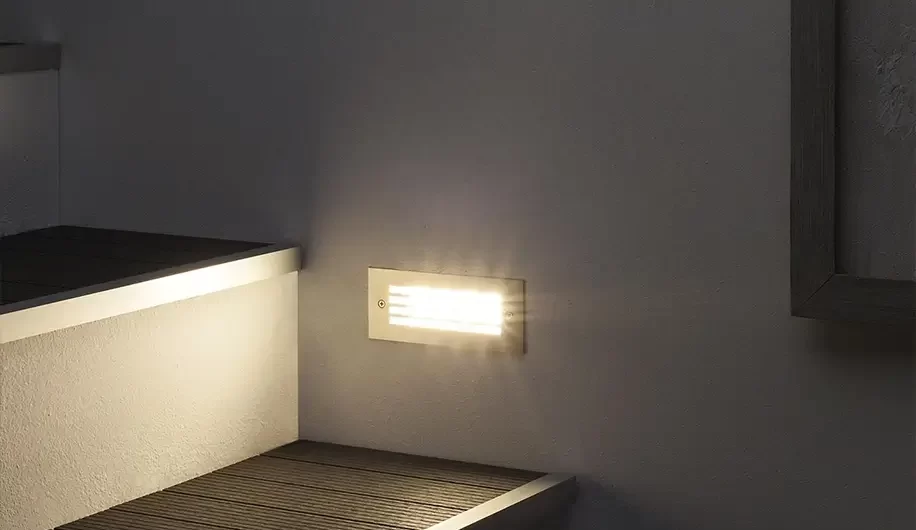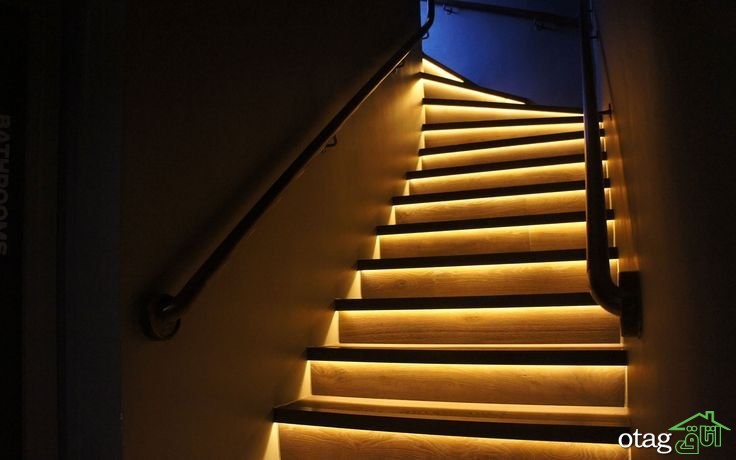Stair lights are a type of lighting fixture used to illuminate and beautify stairs. These fixtures are usually recessed or surface-mounted and can be in a variety of shapes, such as round, square, and rectangular. Stair lights typically use LED technology, which is energy efficient and long-lasting.
For example, stair lights and stair tread lights can be recessed into the side walls of stairs to provide soft lighting along the stairwell. These fixtures are commonly used indoors and outdoors and can add a beautiful, modern look to a space.

Steps to Designing a Staircase Light
Designing staircase lights requires attention to detail and the use of appropriate materials and technologies. Here are some principles and steps for designing and building staircase lights:
1. Choosing the Type of Light: Staircase lights can be recessed, wall-mounted, or LED strips. Each of these types of lights has its own characteristics and uses. For example, recessed lights are installed inside the stairs and shine light upward, while wall-mounted lights are installed next to the stairs and illuminate the path.
2. Choosing the Right Materials: The materials used in the construction of staircase lights must be resistant and durable. Aluminum, stainless steel, and heat- and impact-resistant plastics are usually used.
3. Designing the Lighting System: The lighting system must be designed in such a way that the light is distributed evenly and without creating annoying shadows. Using high-quality LED strips can help create uniform lighting.
4. Installation and commissioning: The installation of stair lights must be done with care and attention to detail. To install recessed lights, the exact installation location must be determined and the lights must be placed correctly in their place. Also, wiring and connections must be done in a way that ensures the safety and efficiency of the system.
5. Attention to safety: One of the most important points in the design and construction of stair lights is attention to safety. The lights must be installed in a way that reduces the risk of slipping and falling and illuminates the stair path well.
6. Use of smart technologies: The use of motion sensors and smart systems can help improve efficiency and save energy. These systems can automatically turn the lights on and off and adjust the amount of light based on need.
Different Types of Stair Lighting
1. Under-Step Lighting
Features: Lights are installed under the edge of the stairs and produce soft and uniform light.
Application: Suitable for modern and minimalist spaces.
Advantages: Creates a beautiful visual effect and reduces shadows.
2. Side-Step Lighting
Features: Lights are installed in the wall or side surface of the stairs.
Application: For spaces with a wall adjacent to the stairs.
Advantages: Increases safety and emphasizes architectural lines.
3. Strip Lighting
Features: Using LED strips installed on the edges of the stairs or under them.
Application: Suitable for modern spaces, restaurants and commercial centers.
Advantages: Low energy consumption and color changing capability.
4. Inset Lighting
Features: Lights are embedded in the stairs or the adjacent wall.
Application: For luxury spaces and special architectures.
Advantages: Creating a delicate and beautiful effect.
5. Spotlight Lighting
Features: Using small spotlights at specific points on the stairs.
Application: To emphasize specific sections or unique stairs.
Advantages: Creating a contrast of light and shadow.
6. Concealed Lighting
Features: Lights are placed behind or under the stairs so that the light source is not visible.
Application: For spaces that require subtle lighting.
Benefits: Creates a sense of depth and visual appeal.
7. Glass Stair Lighting
Features: Light passes through the glass of the stairs.
Application: Suitable for glass or modern stairs.
Benefits: Creates a bright and luxurious effect.
8. RGB Lighting
Features: Uses LED lights with color-changing capabilities.
Application: In commercial environments, clubs, and special spaces.
Benefits: The ability to customize colors to create different moods.
9. Motion Sensor Lighting
Features: The lights automatically turn on and off when people move.
Application: Suitable for smart homes or buildings.
Benefits: Energy saving and increased comfort.
10. Combined Lighting
Features: Combination of several different styles such as hidden and spot lighting.
Application: For spaces that require more complex effects.
Benefits: Create more visual appeal and increase design flexibility.
11. Surface-Mounted Lighting
Features: Lights are installed on the surface of the stairs or wall.
Application: In classic and traditional spaces.
Benefits: Easy installation and easy access for repair.
12. Overhead Lighting
Features: Light is projected from ceiling lights onto the stairs.
Application: For large and public spaces.
Advantages: Wide and uniform light coverage.
Introducing Shamim Andisheh Company
With years of experience and effort, and by utilizing experienced specialists, Shamim Andisheh Company has been able to step into this field as a dedicated designer and manufacturer of standard and customized stair lights and has succeeded in producing various stair lights for its projects.
Shamim Andisheh Company is ready to accept various orders for the design and manufacture of stair lights. Contact us for advice.

 English
English العربية
العربية


















